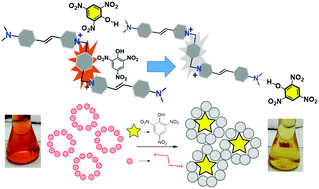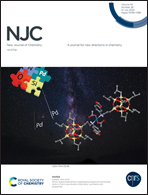A stilbazolium dye-based chromogenic and red-fluorescent probe for recognition of 2,4,6-trinitrophenol in water†
Abstract
The nitroaromatic compounds (NACs) show absorption maxima below 400 nm and their determination using absorption and colour change requires probes with absorption beyond this region. Herein, we report a stilbazolium-based probe DMAS-DP, which undergoes aggregation in HEPES buffer with an absorption maximum at 475 nm (red colour) and these aggregates demonstrate a highly selective and sensitive change in their colour from red to light yellow with 2,4,6-trinitrophenol (TNP). The LOD for the determination of TNP is 100 pM, the lowest in the literature by using visible spectroscopy. Moreover, the aggregates of DMAS-DP emit fluorescence in the red region with a maximum at 615 nm (red under 365 nm light), which is quenched selectively by TNP. 2,4,6-Trinitrotoluene (TNT) and other NACs show insignificant changes in the visible spectrum of the aggregates of DMAS-DP, even when present in excess. Density functional theory (DFT)-based structure optimization studies reveal that the DMAS-DP attains the Z-conformation and its dimethylamino moieties form strong interaction with the protons of TNP and are responsible for the reduced force constant (color). This constitutes the first probe where a stilbazolium dye has been used for constructing a TNP-selective chromogenic and red-fluorescent probe.



 Please wait while we load your content...
Please wait while we load your content...